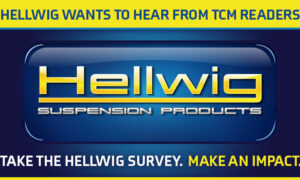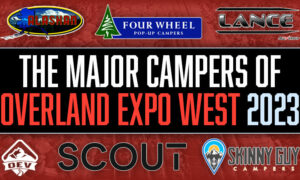Hellwig Products lets a robot drive to test the Electronic Stability Control (ESC) in trucks modified with Hellwig suspension enhancement products.

On September 1, 2012, the US National Highway Traffic Safety Administration (NHTSA) will enact Federal Motor Vehicle Safety Standard 126 (FMVSS 126). This new standard requires that any motor vehicle with a gross vehicle weight rating of 10,000 pounds or less has an Electronic Stability Control (ESC) System that complies with specific design, performance, and diagnostic requirements.
One year later (September 1, 2013), the FMVSS 126 standard will be applied to aftermarket products. While the interpretation of FMVSS 126 is not without controversy, the general consensus on the FMVSS 126 mandate is that any aftermarket product designed for 2011 or newer vehicles cannot interfere or disrupt the performance of the vehicles ESC system.
Obviously the impact of this new standard could be far reaching, impacting the truck camper and truck camper gear marketplace as well as the greater RV industry.
Hellwig Products is taking the lead with SEMA to test their products and comply with FMVSS 126 through self certification. Hellwig Products has already performed tests and is learning a great amount form the resulting data. To tell us about FMVSS 126, the testing, and what Hellwig has learned from the data, we talked to Mark Hellwig, President of Hellwig Products.
The following is an interview with Mark Hellwig, President of Hellwig Products, about the Hellwig Product testing with SEMA.
TCM: What brought about Hellwig’s product testing with SEMA?
Mark: The national traffic safety administration imposed FMVSS 126 in 2005. To comply, the automotive manufacturers had to have electronic stability control (ESC) in their vehicles by 2011.
Aftermarket companies that produce parts designed for vehicles need to compliant with FMVSS 126 by 2013. FMVSS 126 contains a mandated aftermarket product standard that states that any aftermarket product cannot interfere with the performance of an ESC equipped vehicle.
For the past four or five years, SEMA has been assembling a team of experts to help aftermarket manufacturers test their products with ESC systems and become compliant with FMVSS 126. Aftermarket products that could impact a vehicle’s handling dynamics, and thus ESC systems, include wheels, tires, coil springs, shocks, anti-sway bars, airbags, and other suspension and steering components. All of these products will need to be compliant for FMVSS 126 by 2013.
When SEMA’s Technology Vehicle Group offered their FMVSS 126 testing, we decided that we needed to get in on the ground floor and take advantage of the testing. At this time, not many aftermarket manufacturers are taking advantage of it. We want to encourage other manufacturers to participate with SEMA and gain compliance.
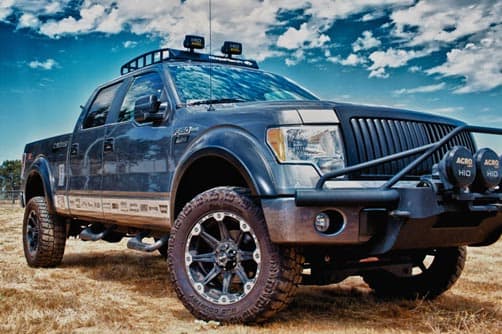
Above: The Ford F-150 used in the testing
TCM: What does it mean to say you’re certified compliant with FMVSS 126?
Mark: The aftermarket manufacturers will self certify that their products will not interrupt or disrupt electronic stability control on vehicles equipped with the technology. My concern is that manufacturers may simply state that they are certified, but not do the testing. To be fair, the testing is expensive and involved.
I am not comfortable with stating we’re compliant without the prudent testing. With the SEMA testing and other testing we’re running, Hellwig’s certification will be backed up with data and analysis provided by independent experts including the SEMA team.
TCM: You and Melanie White, Marketing Director for Hellwig Products, participated in a FMVSS 126 presentation at SEMA last month. Tell us about what was discussed.
Mark: One of the most interesting topics that was discussed was insurance. As a company, Hellwig cannot self insure for product liability. Since we insure through an insurance company, the insurance companies will require us to be compliant with FMVSS 126 or they will not insure us.
To prove that we did our due diligence to certify our products as compliant, we need to conduct the testing. Some of the larger aftermarket companies can self insure so they may not need to have the same proof of testing.
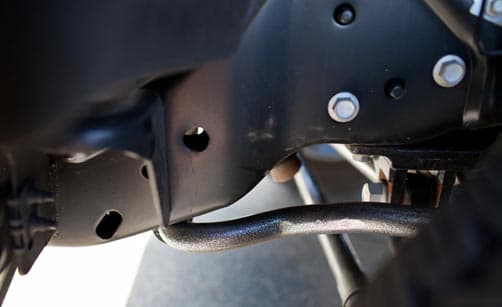
Above: The Ford F-150 with a Hellwig sway bar
TCM: Sometimes I think these laws are actually a product of the insurance companies who lobby for new ways to raise rates and exclude companies they view as too high of a risk. Tell us about the testing that you performed with SEMA.
Mark: We rented a large flat area at the local airport for SEMA’s driving tests. We provided two vehicles, a Ford F-150 and a Ford F-250. The F-150 was modified with a lift kit, larger tires and wheels, and our Hellwig aftermarket suspension enhancement products already installed. With the Ford F-150, we did a reverse test and collected the data with Hellwig front and rear sway bars.
 |  |  |
TCM: How did you collect the data?
Mark: The SEMA technicians had gear in the vehicle to gather the data. Once their testing gear was installed, they jumped in the truck and started testing the Hellwig products. Once they ran the tests with the Hellwig products installed, we uninstalled the Hellwig products and put on the factory stock products. We left the aftermarket lift kit, wheels, and tires, but otherwise the truck was stock as it was delivered from the factory including the stock sway bars. Then they ran the same battery of tests and compared the data.
TCM: What did you do with the Ford F-250?
Mark: The SEMA team tested the F-250 stock including the stock tires, wheels, and sway bars front and rear. Then the SEMA team went through the rigors of their testing. Once that was completed, we installed Hellwig front and rear sway bars, ran the tests again, and compared the data.
TCM: What did the data tell you?
Mark: For both trucks, the Hellwig products did not interfere with the performance of the electronic stability control. The data never went outside of the box that defines the ESC system requirements.
 |  |  |
TCM: That must have been a relief. Can you tell us about the driving tests they were performing?
Mark: The test included high speed J turns where the testers would accelerate and then whip the wheel and let the throttle off and collect data during the deceleration.
They were gathering data on three specific aspects of the vehicle dynamics; roll, pitch, and yaw. Roll is when the vehicle starts to roll on corners. The pitch is the when the vehicle nose dives or raises with braking. Yaw is when the vehicle begins to spin out of control or push through a turn. This is also called oversteer.
The SEMA team gathered all three points of data and plotted them onto a chart. On the chart we could visually see if the vehicles were inside the required box.
TCM: What have you learned from the data collected during the SEMA testing?
Mark: In its simplest terms, our vehicles do not interrupt the control of the ESC systems. WIth the yaw rate, we actually improved the vehicle’s handling and made it a safer and better handling vehicle. We already knew that our products reduced body roll or sway. The test results prove that we also improve the vehicle’s handling dynamics.
TCM: Have you seen any opportunities from the test data to potentially improve the performance of your products?
Mark: What the testing has forced us to do is look closer to how we design and develop products. With the testing and data, we will be offering a more refined product to the consumer. For example, the testing has forced us to be more refined in developing sway bars and considering them with the rest of the chassis components including the center of gravity of the vehicle. It’s a good education curve for our engineers and designers, and has side benefits for us as a company.
 |  |  |
TCM: Tell us about the steering robot in the pictures.
Mark: The steering robot was only on the F-250. That piece of equipment is around $200,000 dollars. There were three technicians running the stuff in the car. One had control of the vehicle, another was programming next test regime, and another was programming the robot. It was quite a process.
I should throw this in as part of the discussion. Technically, we were only running a pseudo FMVSS 126 test. If we were to conduct a complete test, we would have to take into consideration weather conditions, tire tread, brake condition, added weight of passengers, etc. We did not incorporate every possible variable into our test. We didn’t burnish the brakes, measure the tire tread, monitor the tire pressure, and go through different gradients, and test at different times of the day with changing weather conditions.
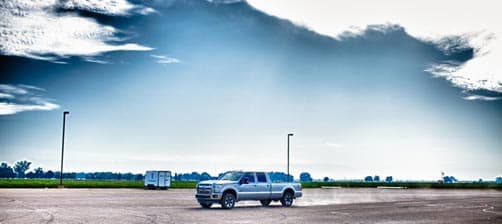
TCM: Listening to you list all of those variables it occurs to me that testing every vehicle with every variable is essentially an impossible task.
Mark: That’s right. SEMA is working with Ford, GM, and Chrysler to try to glean out some of their test data on vehicles so we don’t have to as aftermarket manufacturers go through all that. There should be some relationship that we can nurture with the truck manufacturers to hand down their data.
They’ve done the testing. It exists already. As aftermarket manufacturers, we are reinventing the wheel as far as baseline data in concerned. Beyond baseline, we have to test our products to baseline. For example, we had to measure both trucks without our products to create a baseline.
Look at how many different vehicle types are on the road. The SEMA test was a very expensive proposition. We paid about a third because we got in on ground floor with SEMA, but it’s about $50,000 dollars to go through the full test regime with all the perimeters they require.
TCM: Wow. Is that cost per vehicle?
Mark: Yes, per vehicle. By taking the lead, SEMA has really helped us as aftermarket companies. They realize the potential impact of FMVSS 126. They’re lobbying to get some of the standards impact reduced. The National Highway Transportation Safety Administration is almost arrogant about FMVSS 126 and how manufacturers need to comply at almost any cost. Their attitude is, ‘This is what we are going to do and you will comply and your arguments don’t have any validity to them’.
TCM: Do you think it’s possible that the truck camper industry will be impacted by FMVSS 126?
Mark: That’s an excellent question and we don’t yet know the real answer.
People use truck campers for so many applications. Again, it would be impossible to police everything. For example, take a company who sells fifty-pound bags of sand. One of their customers loads up their truck camper bed with the bags of sand. Is the company who sold the sand liable for the change in ESC performance caused by the sand bags? Does he need to become compliant with FMVSS 126 with his sand bag products?
I don’t think camper manufacturers are going to need to test to the FMVSS 126 standard. I just can’t see this happening and being mandated on truck camper industry.
I think this whole FMVSS 126 thing is evolving as we go. There are going to be unintended consequences. The aftermarket product market is a multi-billion dollar industry. If FMVSS 126 causes the loss of our industry, the impact on the economy would be huge.
TCM: This whole thing seems like the asteroid that passed our planet a few weeks ago. It will either be a planetary killer, or just pass us by.
Mark: I think it’s all going to work itself out. Back in the eighties, it was anti-lock brakes. We survived that. And like anti-lock brakes, electronic stability control is a good safety measure that will help drivers to maintain control of their vehicles. The concern is how FMVSS 126 will impact our industry.
TCM: How is Hellwig Products doing?
Mark: We’re doing well. Steel costs are high right now, which is giving me grief. And we always have new products to develop and sell.
TCM: Are you hiring?
Mark: Yes, we are hiring. This is our traditional slow time as we move through January. I hired through the summer, but now orders will slow down, so we may lay people off in the winter. I really don’t like doing that, so I probably will just lay back on hours.
TCM: Are you developing any new products that would be relevant to the truck camper marketplace that you can tell us about, or tease?
Mark: We have the Big Wig sway bars for truck campers. We have also begun a study for a line of helper springs for truck campers, the Big Wig helper springs. They are in the early development stages right now, and will work with the Big Wig sway bars. The Big Wig has been successful.
TCM: Thanks Mark. Keep us in the loop with FMVSS 126.
Mark: I will.







